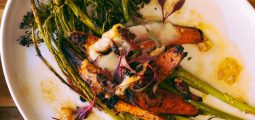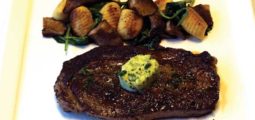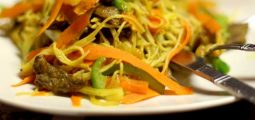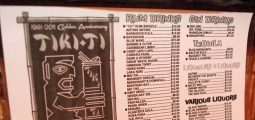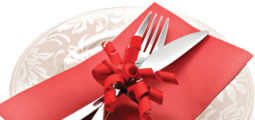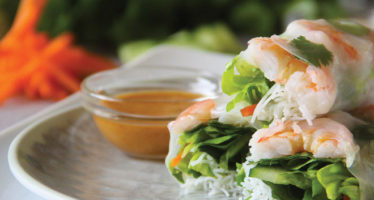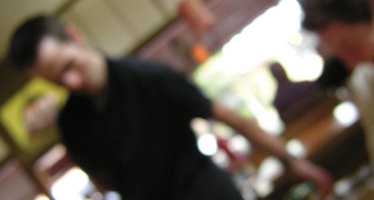Sous Vide, Not Paleo but Prehistoric
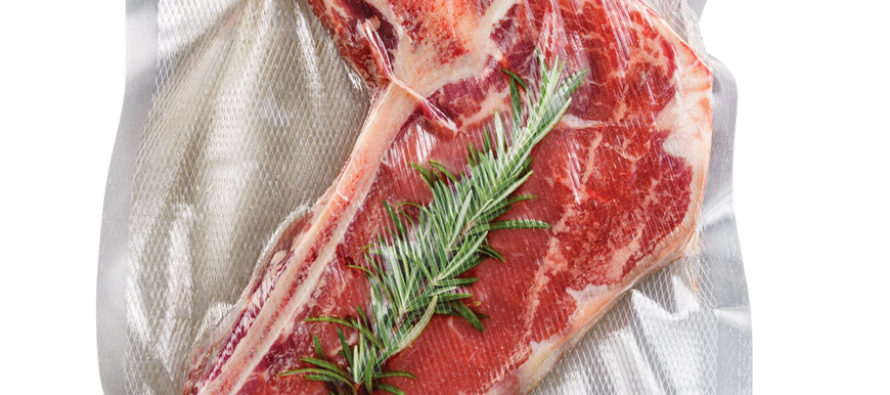
Sous-vide, or just unhyphenated sous vide cooking is cooking under vacuum. Say, “soo-veed.” Don’t pronounce the terminal S or the final E and you’ll be square with any waiter. Rhyme the first word with grouse and say, “souse viday” and you’re likely to get some sort of pig entrails in a bedpan. It’s true, only the French could conceive pronunciation so fickle, but truth be told, they didn’t invent the thing at all.
That honor goes to 18th century globe-trotter Benjamin Thompson, a Yankee born and bred to middle class parents who charmed a rich widow into marriage. He joined up with the loyalists, fought against the American Revolutionary forces, then abandoned his rich Massachusetts wife and fled to Britain where rat-finking against your soon-to-be-country paid well, and rose in the military ranks. Then he was off to Bavaria, where he reorganized their army: its structure, diet and wardrobe, invented the double boiler and did heat experiments, invented a fireplace, published a lot of rubbish papers, designed gardens, married Courvoisier’s widow, was knighted by King George III (the crazy one,) and became Count Rumford of the Holy Roman Empire. Rat-finking apparently forgotten, he then endowed a professorship at Harvard and a medal at the American Academy of Arts and Sciences. (Count Rumford. Wikipedia. Retr. June 2, 2016 from https://en.wikipedia.org/wiki/Benjamin_Thompson) Weird. But he did some calculations on heat transfer that, although less accurate, pre-dated and anticipated Joule’s work.
One night he sort of left a “wonderful shoulder of mutton” in some sort of box or “machine” all night (maybe the sort of thing one rocks a Cuban pork roast in, he doesn’t specify) and in the morning, “It was perfectly tender but though it was so much done it did not appear to be in the least sodden or insipid on the contrary it was uncommonly savoury and high flavoured. It was neither boiled nor roasted nor baked Its taste seemed to indicate the manner in which it had been prepared that the gentle heat to which it had for so long a time been exposed had by degrees loosened the cohesion of its fibres and concocted its juices without driving off their fine and more volatile parts….” (Complete Works, Vol.4, 1876)
The idea of sous vide was turned into a commercial cooking method by French and American engineers in the1950’s — maybe what was good enough for the Bavarian Army was good enough for industrial kitchens — and voila! Airline food was born, and no one has managed to kill it yet. And then in the 1960’s, some French guys (Pralus. La Cuisine Sous Vide. 1985) at a little restaurant called Troisgros figured out that vacuum sealing and poaching foi gras was superb, and voila! A not-so-new technology was born and migrated onto the Food Channel.
You can’t buy a sous vide; it is a method of cooking that involves sealing food (shrimp, beef, veggies, pickling spices and cauliflower) in heavy duty plastic bags and sucking the air out with a vacuum sealer, then immersing said bags into a container of water that is held at a constant low temperature (111-140˚) by a hefty space-age heat-generating stick called an immersion circulator that looks like something you’d use to take a rhino’s temperature. This device has numbers and blinking lights and it circulates the water like a teeny trolling motor and keeps whatever you are cooking at a steady temperature for as long as it’s on.
With sous vide, you set the temperature for the temp you want at the end, and it stays there. So you can hold your perfectly rare steak at that temp and it won’t get any less rare. Your moist tender shrimp or your braised beets won’t come out hammered if you forget them, and you can flip anything out last minute and shove it under the broiler, flash sear it in a pan or grill, or torch it till it browns and sizzles. Now you can see why a restaurant (or an airline kitchen, or someone in a 5th-floor walkup with no stove) might find this process really useful. You can even make hollandaise sauce in these things and it won’t burn or curdle. You can witness this and other sous vide miracles at the cooking blog, Chef Steps, at www.ChefSteps.com. They will also be putting out a new immersion circulator called “Joule,” which I think sounds better than “Rumfeld.”
Now sous vide is used in a great many restaurant kitchens, but as chef/owner at Salt 88, John Horvatinovich says, “back in the day, it was unusual technology and only high-end kitchens could afford them. Now, it’s another tool in the box.” And it goes for the same in home kitchens. When Iron Chef Japan reintroduced this thing to the world, you had to be an iron chef to afford the circulator and the vacuum sealer because they were like the first car phones: ginormous, rare and very spendy. Now, the price has come down considerably. You can get bags, a sealer, and a circulator (the thermometer thingy) and get yourself a pot or plastic tub or small cooler and sous vide anything within reach.
Fun, huh? But why would anyone do that?
Because sous vide cooking is magic. It employs a wet method of cooking and one of the most powerful weapons known to cookery: convection. When you put food in a skillet, it has to touch the skillet which has to touch the heat source, but it only cooks where the pan conducts the heat. We all know convection as the steroid-enhanced big brother of ovens, cooking faster, and often better than the indirect heat of a regular oven. The convection oven has a fan that keeps the air circulating and increases convection or heat transfer (recall Count Whatshisface.) And with kicked up insulation, works very well. Water, however, blows air out of the kitchen.
If your water is hotter than your food, it transfers heat so much better than air to the whole mass of whatever you’re cooking because it’s denser. And moving water transfers even more heat. But it goes both ways. Hypothermia cases almost always take place in water because mere exposure to the elements isn’t usually enough to rob your entire body of heat. But put that same person in cold running water and they will go into shock and die before you can preheat your oven. That’s why frozen food in plastic thaws quickest in running water (see Alton Brown’s How to Thaw a Frozen Turkey.) Hence convection, hence the circulation. And vacuum sealing means there’s no air to insulate the food, which is slightly under pressure which can speed things up even more.
So what happens to sous vide food? Told you, it’s magic. Better than braising or boiling or poaching because the food is surrounded and in constant contact with whatever you put inside the bag: poaching liquid, pesto, herbs and spices, natural juices… The encapsulated food doesn’t dry out as it can in many other indirect applications, including braising, and the flavor isn’t diluted — a very important attribute, especially when looking at longer cook times. It’s low, slow. Connective tissue breaks down. Flavor intensifies.
Final bonus: you don’t have to babysit it. In fact, you can’t. You plop your flavor packets in the water, close the lid (at home, we use a cheap cooler with a hole drilled in the lid for the circulator) and no peeking! Leave it alone, for hours if you like, and go take a nap while nothing gets overcooked. New technology can work for you, only it isn’t really new. We’ve been doing it since we started cooking.
The real history of sous vide, I would argue, is the history of man. Let’s skip the 1700’s and skip back to two million years ago, about the time Homo habilus met a slightly more uptown form of hominid: Homo erectus. Habilines may have been hairy, but they were upright, and they cranked out stone tools like we do iPads. In terms of fine cuisine, they knew all about hacking up carcass bones to get the marrow, something highly thought of in charcuterie. But alas, as far as we know, hacking was the limit of their kitchen prep. Recently in the journal, Nature, evolutionary biologists Katherine D. Zink and Daniel E. Lieberman, (March 2016. p. 16990) said that our stone tools helped us cut up stuff, which allowed less chewing, which gave us more energy, which fueled the big jump in brain size and body shape that we see in H. erectus who was as like us as you can get without being us.
As tantalizing as it is to think that mushing up our food made our brains big, I doubt it. After all, babies eat nothing but mush, and you’ve never seen them even start a crossword. For those who have never read The Far Side comics, that baby thing was a joke. Evolution doesn’t work like that.
My bet is snugged in the same pocket as that of Richard Wrangham, an imminent biological anthropologist and primatologist with a résumé longer than human evolution. Wrangham says that stuff about mushing is twaddle. It wasn’t tools, mushing, hunting, or running around that jacked up our brains. It was fire. Michael Pollan’s recent book and documentary series Cooked seems to come down on the fire-side, and I am right there, roasting my prehistoric wieners.
Wrangham explained at length in his incredible book, Catching Fire, How Cooking Made us Human (2010) that every single society known to man, no matter how specialized, uncivilized, or grubby, cooks its food. He blows up some myths about tribes who eat raw food, saying that raw is preferred only in certain cases where the food is easily digestible (like with seal blubber) or already really soft (never you mind what) but that overall, the taste of cooked food is always preferred.
And why do we like our food cooked? As Wrangham says, it provides us with more available calories, and more energy, because, in a sense, cooking is pre-digestion. We have less chewing, waste less energy digesting, and end up with food that doesn’t spoil nearly as rapidly. Many nonhuman species even prefer cooked food. And everyone agrees, except for those raw food people who, like good vegans, can only survive on their special diet because it is highly processed, not yanked from the ground, highly domesticated, not sour and tiny or lean and stringy, and readily available in natural food marts not gathered after a nine hour sojourn in the bush. We cook, therefore we are, human. And we have been doing it forever. How do I know this? Because people and their ancestors are really freaking smart and we didn’t have immersion circulators and microwaves so we had to figure stuff out. Don’t believe me?
Neanderthals, nobody’s dumb cousins, (Nova, 2012) mined bitumen and dry-distilled birch resin, not just over a fire, but in an oxygen-reducing oven (like is used to make charcoal) to make superglue that surpasses modern standards over 200,000 years ago. And they glued on their spear points and went off and killed mammoths. What? You think they just tripped over the birch bark? Accidently murdered a whole mammoth with crazy technology? That manipulation of fire and chemistry shows some sophisticated chops right there. So you know we’ve been using fire for millions of years.
One of the most ancient one-pot dishes is haggis, and it dates way before the Romans; no one knows how old. Stuff some tough meat and whatever else in a sheep’s stomach and immerse in a pit of water heated with hot rocks. And what would you do if you had some meat and a carcass (with entrails!) and no cooking vessels? You could use a stick to create a rotisserie, but that takes time and you end up with the burnt marshmallow equivalent of game meat. Good luck chewing it. Or, you could wrap it up in something, palm leaves, banana leaves, grape leaves, all good, but what if you didn’t have large-leafed plants or it was winter? What about those entrails? Could work.
But we didn’t have to figure mutton out from scratch because we’d already learned how to cook stuff that couldn’t run away. Oldest domesticated animal on the planet? Snails. They don’t run, and they come in their own handy casserole shell—fire pit to table. And scientists like Wrangham say we did this really early on in our evolution. But there is one small problem.
There is no evidence in the archaeological record for cooking with fire as far back as the one to two million year (erectus) range. And even though most believe there must be evidence somewhere, a fire and some buried bits of food don’t preserve very well. Still, there are many food historians like Pollan, who think that fire + food = big brain. It only means that we haven’t found the evidence, not that we won’t. Then again, most of it might just be under water.
Which takes us back to sous vide. Water is what we are talking about here. Water + fire + food. You think that sounds like grandma’s stove? Think again. Cooking stuff wrapped up for maximum convection is so ancient we had time to lose it and re-find it and make a big deal out of it. So I groan when paleo-people scientists say, “Wow, early people were way more sophisticated than we thought.” No. We were smart. We figured out how to chop, dice, puree, and sous vide quite nicely. Because there was food and fire everywhere, and we were really hungry.
Hefty evidence of hominid migration shows that H. erectus moved out of Africa and just toodled along the coast from one freshwater inlet to the next. We must have been renewing our love of things in shells. Why not? We were great at finding food, and where better to find heaps of it than coastal waters. You got mussels, clams, oysters, and all manner of little scurrying tidal creatures. Make a fire pit, if you have anything without a shell, say a wild pig wanders down for a drink, you wrap it in seaweed or leaves, fire it and leave it. Gives you plenty of time to invent surfing. And when you’re tired of that spot, toodle up the coast again ‘til you find another inlet and hang there.
People say it’s eggs, but evolutionarily speaking, shellfish is nature’s perfect food. It’s the only food you can eat exclusively and get enough fat in your diet to feed your hungry brain. And it’s the only thing that contains the exact right balance of essential vitamins, minerals and amino acids to live on. Need fiber? Have a go at that seaweed. And that’s how people populated the world. Cruising up the coast, clamming, chilling and chowing. And this leaves a lot of what is probably the earliest evidence of cooking under water. Sea levels have fallen and risen (we had coast before, now not so much) and so the next really big wave of archaeologists is going to come dressed in scuba gear. In fact, it has already begun. The earliest evidence of human cooking will be found, betcha, right where the former coast was, where some wandering families dug a fire pit and made a lovo.
If you ever get to Fiji, you must try the lovo dishes: protein or root vegetables wrapped in banana leaves, and immersed in a pit oven full of charcoal, hot rocks and slowly cooking food, all pressed together and covered over for maximum convection. This sort of thing is done all over the world in indigenous societies, at Luaos in Hawaii, and we have the exact same oven used to cook mammoth bits at a site dating from 200,000 years ago. But ten will get you twenty there are some that are a lot older.
Convection, slow-cooking, preserving. We lost this very elemental art, stumbled over it on the way to the pantry, and then ran around the kitchen acting like we’d discovered something really new. As Kevin Newlin, Kroc Banquet and Community Center’s executive chef, told me, “Sous vide began as this very French, very trendy, high-end thing. As a young chef, it was intriguing to me because it was so different.” As a former instructor of garde manger (it means “food keeper”) at the Institute for the Culinary Arts at Metro Community College, he taught students the art of preserving, curing, pickling and cheese-making. Sous vide, he says, is wonderful for pickles and is also a killer way to process meats for curing. Kevin added, “Now sous vide is on menus everywhere and it’s about refining technique and adapting it to fit your style. It makes you more versatile as a chef.”
And he proved his versatility recently at a fête/pop-up with Block 16, Gray Plume and chef Bryce Coulton called “Charcuterie Partuterie” where he helped cover a whole 24-foot table with gorgeous dainties showcasing local Nebraska ingredients. His contribution: duck pâté en croûte around a smoked tenderloin with aspic with pistachio jam. At least I think that’s what he said, I was too busy crying that I couldn’t go eat it that weekend. Kevin’s take on sous vide for pâté? “There’s nothing better, it’s absolutely perfect.”
Now that immersion circulators and vacuum sealers are essential in the restaurant and well-heeled home kitchen, the pretentious-sounding name, sous vide, just rolls off the tongue like candied bacon ice cream, which, by the way, you can make sous vide.

Ann Summers
Ann Summers is not a 40-umpthing-year old rock climber who got shut down in Boulder Canyon and drowned her failure in a microbrewery. She is neither a mother of two, a fan of Latin plant names nor a lover of fine Italian Grappa. You’ll not catch her shooting guns for fun or hollering like a redneck. She hates Shakespeare, and doesn’t call a certain fast food chain “The Scottish Restaurant.” She turns her nose up at organic yellow beets, eschews fresh oysters, and loathes chubby guinea pigs with Violent Femmes hairdos. She is also a dreadful liar
Related Articles
A Bite of Spring: Spring Rolls Recipe
Spring rolls are a classic Vietnamese appetizer that I discovered in the late 80’s/early 90’s at the long closed midtown
Food Service Warrior: What’s a ‘Real’ Job?
I have been working in the restaurant industry for about the past five years now and I currently bartend at
Bites & Sips: Issue 18
MCC’s Sage Student Bistro Sage is now open during the College’s fall quarter. Lunch hours are Monday-Thursday, 11am-1:30pm, and dinner
No comments
Write a commentOnly registered users can comment.
